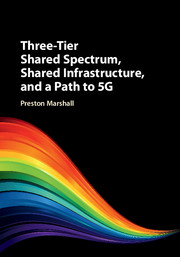Book contents
- Frontmatter
- Contents
- Acknowledgments
- Preface
- Part I Spectrum Sharing Background
- Part II Three-Tier Dynamic Spectrum Models
- 3 Key Aspects of PCAST Recommendations
- 4 US FCC CBRS Regulations, and Other International Activity
- Part III Components of a Three-Tier Architecture
- Part IV Protection Processes for Incumbents and Peers
- Part V Example Use of Three-Tier Spectrum: Use of the 3.5 GHz CBRS Band in the USA
- Part VI Future Bands, Network Services, Business Models, and Technology
- Part VII Appendices
- Index
- References
4 - US FCC CBRS Regulations, and Other International Activity
from Part II - Three-Tier Dynamic Spectrum Models
Published online by Cambridge University Press: 30 August 2017
- Frontmatter
- Contents
- Acknowledgments
- Preface
- Part I Spectrum Sharing Background
- Part II Three-Tier Dynamic Spectrum Models
- 3 Key Aspects of PCAST Recommendations
- 4 US FCC CBRS Regulations, and Other International Activity
- Part III Components of a Three-Tier Architecture
- Part IV Protection Processes for Incumbents and Peers
- Part V Example Use of Three-Tier Spectrum: Use of the 3.5 GHz CBRS Band in the USA
- Part VI Future Bands, Network Services, Business Models, and Technology
- Part VII Appendices
- Index
- References
Summary
Introduction
This chapter describes the rule-making process and formal requirements that were established by the United States (US) Federal Communications Commission (FCC) to implement the first three-tier band, the Citizens Broadband Radio Service (CBRS) band from 3.55 to 3.7 GHz [1, 2]. This chapter will describe the regulatory requirements only; methods for implementing them, and other three-tier regimes, are provided in detail in subsequent chapters.
The chapter closes with a discussion of movement towards three-tier spectrum management that has occurred outside of the USA. None of these is yet as mature as the USA regulations, but are different national approaches to creating a similar ecosystem.
This chapter is not intended to advocate for the specifics of the US three-tier framework. It compromised some principles of the PCAST vision of three-tier; these compromises may be undesirable, or may be improvements. They may or may not be relevant to the issues faced by other countries, and in other bands, when adopting the three-tier framework. Instead, the US three-tier framework is presented as a point of departure from which it is likely that consideration of other bands, and other countries, will depart.
Repeating a quotation cited in the first chapter, the intent of this band was stated by the FCC as [2]:
“The Citizens Broadband Radio Service takes advantage of advances in technology and spectrum policy to dissolve age-old regulatory divisions between commercial and federal users, exclusive and non-exclusive authorizations, and private and carrier networks.”
The FCC actually issued its first interest in, and support of, the President's Council of Advisors on Science and Technology (PCAST) recommendations a few months after the formal release of the PCAST report [3]. There was an unprecedented amount of support in the administration, as shown in Figure 4.1. This figure shows the support for the PCAST release event, including the Chief Information Officer (CIO) of the Department of Defense (DoD), Assistant Secretary of the Department of Commerce (DoC) and Director of the National Telecommunications and Information Agency (NTIA), the Deputy Director of the White House Office of Science and Technology Policy (OSTP), the Chairman of the FCC, and the Chairman of the Council of Economic Advisors (CEA).
- Type
- Chapter
- Information
- Publisher: Cambridge University PressPrint publication year: 2017

